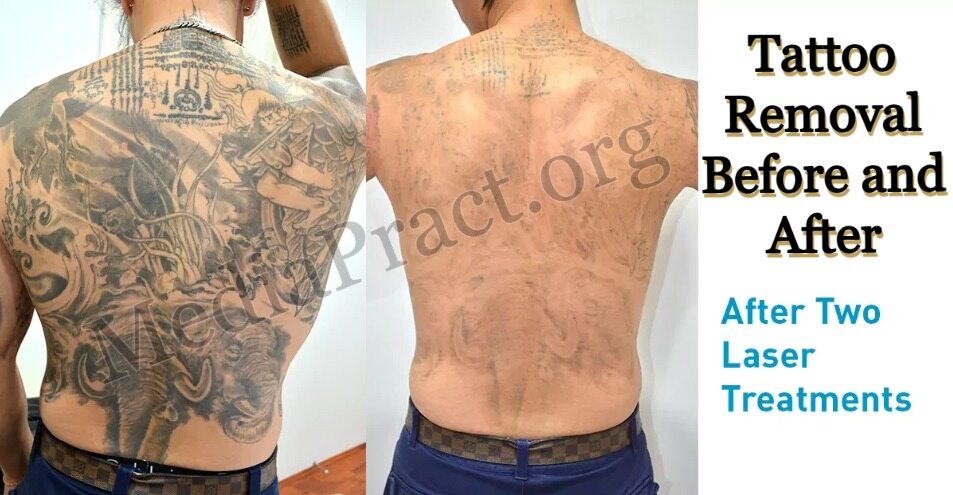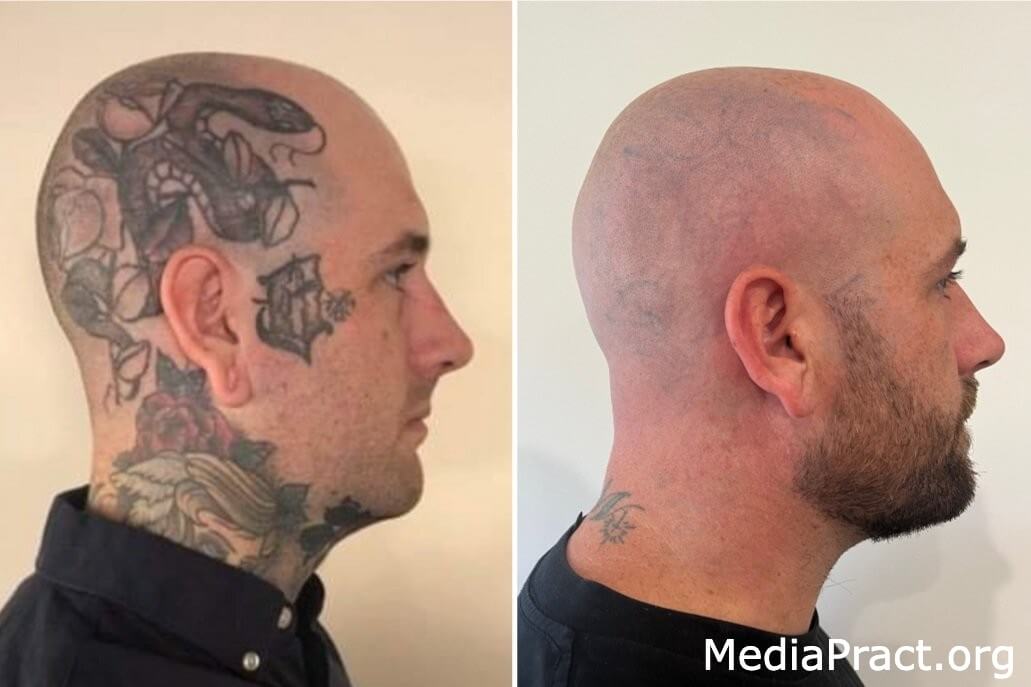Tattoo removal has evolved significantly in recent years, with advanced technology making it safer, more effective, and accessible. For those considering removing unwanted ink, understanding the process, methods, and outcomes is crucial.
This article provides a comprehensive guide to tattoo removal, focusing on before-and-after insights, preparation, methods, and more.
1. Understanding Tattoo Removal: What It Is and Why People Choose It
Tattoo removal is a procedure designed to eliminate or fade permanent ink from the skin. This process can involve various methods, with laser technology being the most effective and widely used.
Why Do People Opt for Tattoo Removal?
- Change in Personal Preferences: Tastes and trends evolve, and some tattoos no longer align with an individual’s identity.
- Professional Reasons: Certain industries have strict rules regarding visible tattoos.
- Poor Tattoo Quality: Low-quality tattoos often lead to regret.
- Room for New Ink: Many individuals remove old tattoos to make space for new designs.
Tattoo removal is about reclaiming control over your body and aesthetics.
2. Tattoo Removal Before and After: Key Expectations

Before Tattoo Removal
Preparation is vital for a successful tattoo removal process:
- Consultation: A professional will evaluate your tattoo, skin type, and health to recommend the best approach.
- Skin Care: Keep your skin moisturized and avoid tanning.
- Manage Expectations: Complete removal isn’t guaranteed for all tattoos, especially those with stubborn ink colors.
After Tattoo Removal
The healing process plays a significant role in the outcome:
- Tattoos fade gradually over weeks as the body breaks down ink particles.
- Minor side effects such as redness, swelling, or blistering may occur.
- Adhering to aftercare instructions ensures quicker healing and better results.
3. Methods of Tattoo Removal
There are multiple ways to remove tattoos, each with benefits and limitations.
3.1 Laser Tattoo Removal
The gold standard for tattoo removal, lasers work by emitting light that breaks the ink into tiny particles, allowing the body to naturally eliminate them.
Key Features:
- Effective on most ink colors, especially darker shades.
- Requires multiple sessions (6–12 on average).
- Minimal scarring risk with proper care.
3.2 Surgical Excision
This involves cutting out the tattooed skin and stitching the area back together.
Best For:
- Small tattoos in areas with extra skin.
Drawbacks:
- Invasive and leaves a scar.
3.3 Dermabrasion
Dermabrasion sands off the tattooed skin using a rotating device.
Pros:
- Suitable for small, shallow tattoos.
Cons:
- Painful and may result in scarring.
4. Factors Affecting Tattoo Removal Results
Not all tattoos are equally easy to remove. Several factors influence the process:
- Tattoo Age: Older tattoos often fade more quickly as the ink deteriorates over time.
- Ink Colors: Black and dark blue inks are easier to remove, while lighter colors like yellow and green are more resistant.
- Skin Type: Different skin tones require tailored laser settings for safety and effectiveness.
- Tattoo Depth: Deeply embedded ink takes more sessions to fade.
- Tattoo Size: Larger tattoos may need multiple treatments per session.
5. How to Prepare for Tattoo Removal

Preparation ensures a smoother process and better results:
5.1 Consult a Specialist
A consultation helps identify the best method for your tattoo. Professionals can also provide an estimate of the sessions needed.
5.2 Protect Your Skin
Avoid sun exposure and tanning for at least two weeks before treatment.
5.3 Stay Hydrated
Well-hydrated skin responds better to laser treatments.
5.4 Avoid Certain Products
Stop using skincare products that contain retinoids or acids on the tattooed area.
6. Aftercare Tips for Tattoo Removal
Proper aftercare ensures quicker healing and reduces the risk of complications:
- Keep the Area Clean: Gently wash with mild soap and water.
- Apply Ointment: Use prescribed ointments to keep the skin hydrated and prevent infections.
- Avoid Picking Scabs: Let the skin heal naturally to avoid scarring.
- Protect from the Sun: Use sunscreen or cover the treated area.
7. Tattoo Removal Before and After Pictures: Setting Expectations

Viewing before-and-after photos helps set realistic expectations. Look for images of tattoos similar to yours in terms of size, color, and placement to understand what to anticipate.
8. Tattoo Removal Cost: Breaking Down the Expense
Tattoo removal costs vary widely based on several factors:
- Size of the Tattoo: Larger tattoos are more expensive to remove.
- Number of Sessions: Most tattoos require 6–12 sessions.
- Technology Used: Advanced lasers may cost more but deliver better results.
- Location: Urban clinics may charge higher rates than rural ones.
On average, laser tattoo removal costs range from $200 to $500 per session.
9. Alternatives to Tattoo Removal
If complete removal isn’t an option, consider these alternatives:
- Cover-Up Tattoos: Work with a skilled tattoo artist to design a new tattoo that covers the old one.
- Tattoo Lightening: Reduce the tattoo’s visibility enough to apply a cover-up.
- Temporary Concealers: Use high-coverage makeup to hide tattoos for special occasions.
10. Risks and Side Effects of Tattoo Removal
While tattoo removal is generally safe, some side effects can occur:
- Temporary Discomfort: A stinging sensation during laser treatments.
- Swelling and Redness: Common and short-lived reactions.
- Blistering and Scabbing: These are part of the healing process but require proper care.
- Pigment Changes: Some people experience lightening or darkening of the skin.
- Scarring: Rare but possible with improper aftercare.
11. Success Stories: Tattoo Removal Transformations
Hearing about others’ experiences can be inspiring. Many people share stories of regaining confidence and moving forward after successful tattoo removal.
12. FAQs About Tattoo Removal
Q1: Does tattoo removal hurt?
A: Most patients compare it to snapping a rubber band against the skin.
Q2: Can all tattoos be removed completely?
A: While most tattoos can be significantly faded, complete removal depends on factors like ink color and depth.
Q3: How long does the process take?
A: Each session lasts 15–30 minutes, and the entire process may take several months.
13. Why Tattoo Removal Is Worth Considering
Tattoo removal offers a chance to align your appearance with your current preferences. Whether you want a clean slate or simply regret your old ink, modern techniques make it achievable.
14. Choosing the Right Tattoo Removal Specialist
Selecting a qualified specialist is essential for safety and effectiveness:
- Check for certifications and licenses.
- Read reviews and testimonials.
- Ensure the clinic uses modern equipment.
15. Final Thoughts on Tattoo Removal Before and After
Tattoo removal is a journey that requires patience, commitment, and proper guidance. By understanding the process and following professional advice, you can achieve the desired results with minimal risks. Whether you’re considering removal for personal or professional reasons, the right approach ensures a successful transformation.
Take the first step toward reclaiming your skin with confidence!

























+ There are no comments
Add yours